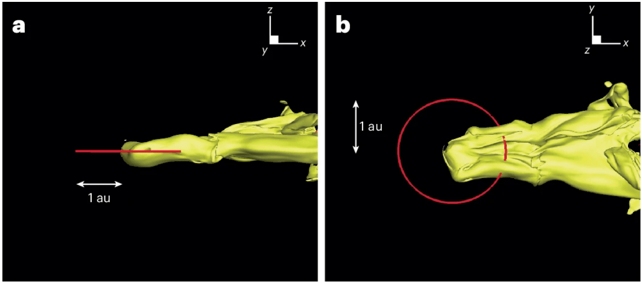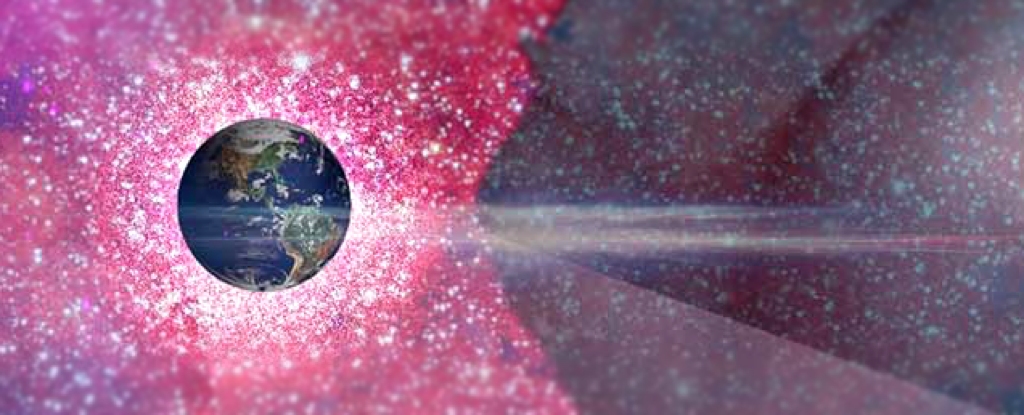Scientists scour the Earth and the sky for clues to our planet’s climate history. Powerful and sustained volcanic eruptions can alter the climate for long periods of time, and the Sun’s output can shift Earth’s climate over millions of years.
But what about interstellar hydrogen clouds? Can these regions of gas and dust change Earth’s climate when the planet encounters them?
Interstellar clouds aren’t all the same. Some are diffuse, while some are much denser. New research in Nature Astronomy says that our Solar System may have passed through one of the dense clouds two or three million years ago.
The effect could’ve altered the chemistry of Earth’s atmosphere, affecting cloud formation and the climate.
The research is “A possible direct exposure of the Earth to the cold dense interstellar medium 2–3 Myr ago.” The lead author is Merav Opher from the Radcliffe Institute for Advanced Study at Harvard University and the Astronomy Department at Boston University.
“Our results open a new window into the relationship between the evolution of life on Earth and our cosmic neighborhood.” – Avi Loeb, co-author, Harvard University’s Institute for Theory and Computation
The Sun is moving through a large cavity in the interstellar medium (ISM) called the Local Bubble. Inside the LB, the Sun’s solar output creates a cocoon called the heliosphere. It shields the Solar System from cosmic radiation.
Inside the LB, there’s more than just the Sun. It also contains other stars, and the Local Interstellar Cloud (LIC). The Sun has been moving through the LIC and will leave it in a few thousand years. The LIC is not very dense.
But in the last few million years, as the Sun has traversed the Local Bubble, it’s encountered clouds that are much denser than the LIC. The researchers examined the effect these encounters had on the Sun’s ability to carve out a cocoon for the Solar System and what effect this had on Earth.
“Stars move, and now this paper is showing not only that they move, but they encounter drastic changes.” – Merav Opher, Professor of Astronomy, BU College of Arts & Sciences
“Here we show that in the ISM that the Sun has traversed for the last couple of million years, there are cold, compact clouds that could have drastically affected the heliosphere. We explore a scenario whereby the Solar System went through a cold gas cloud a few million years ago,” Opher and her colleagues write.
Most of what the Sun travels through is thin ISM. The Sun constantly moves through the thin ISM with no effect.
“These clouds are plentiful around the Sun but have too low a density to contract the heliosphere to distances
However, the denser clouds in the ISM are dense enough to dramatically affect the protective heliosphere.
“The ISM in the vicinity of the Solar System also harbours a few, rare, dense, cold clouds that are called the Local Ribbon of Cold Clouds,” they write.
One of the clouds in that ribbon is called the Local Leo Cold Cloud (LLCC). It’s one of the largest clouds in the ribbon, and astronomers have studied it extensively. They know its density and its temperature. Researchers haven’t paid as much attention to the other clouds in the ribbon, but they expect them to be similar.
The authors of this paper say that there’s a small chance, about 1.3%, that the Sun passed through the tail of the LLCC.
“We name that portion the Local Lynx of Cold Clouds (LxCCs). The LxCCs represent nearly half of all the mass of the LRCC and are more massive than the more well-studied LLCC,” they write.
There are questions about the nature of these clouds in the past.
“Note that these clouds are anomalous and unexplained structures in the ISM, and their origin and physics are not well understood,” the authors write. Their work is based on the assumption that they haven’t changed substantially in the 2 million years since the purported encounter.
“We have assumed here that these clouds have not undergone any substantial change over the last 2~Myr, though future work may provide more insight into their evolution.”
The researchers used simulations to study the dense cloud’s effect on the heliosphere and, by extension, our planet. They say that the cloud’s hydrogen density pushed back on the Sun, shrinking the heliosphere smaller than the Earth’s orbit around the Sun.

It brought both the Sun and the Moon into contact with the dense, cold ISM. “Such an event may have had a dramatic impact on the Earth’s climate,” they explain.
The encounter is supported by the presence of the radioisotope 60Fe on Earth. 60Fe is predominantly produced in supernovae and has a half-life of 2.6 million years.
Previous research linked the 60Fe to a supernova explosion, where it became entrenched in dust grains and then delivered to Earth. It’s also present on the Moon. 244Pu was delivered at the same time, also in supernovae ejecta.
While there’s a lot of uncertainty, the researchers say the deposition of 60Fe on Earth lines up with our Solar System’s hypothetical passage through a dense cloud that compressed the protective heliosphere, allowing the isotopes to reach Earth.
“Our proposed scenario agrees with the geological evidence from 60Fe and 244Pu isotopes that Earth was in direct contact with the ISM during that period,” they write.
But if a supernova delivered the radioisotopes, it would have to have been pretty close, and other evidence discounts the supernova source.
“A close supernova explosion contradicts the recent model of the Local Bubble formation,” the authors explain. “The scenario does not require the absorption of 60Fe and 244Pu into dust particles that deliver them specifically to Earth, like the scenario with nearby supernova explosions.”
The question at the heart of this issue is, how did this affect Earth?
An in-depth study of the consequences is outside the scope of this research. The team did comment on some possibilities, while also cautioning that very little research has been done on this matter.
“Very few works have investigated the climatic effects of such encounters quantitatively in the context of encounters with dense giant molecular clouds. Some argue that such high densities would deplete the ozone in the mid-atmosphere (50–100?km) and eventually cool the Earth,” they write.
It’s a leap, but some research suggests that this cooling could have contributed to the rise of our species.
“The hypothesis is that the emergence of our species, Homo sapiens, was shaped by the need to adapt to climate change. With the shrinkage of the heliosphere, the Earth was exposed directly to the ISM,” they write.
In their conclusion, they remind us that the probability that this encounter took place is low. But not zero.
“Stars move, and now this paper is showing not only that they move, but they encounter drastic changes,” said Opher, a BU College of Arts & Sciences professor of astronomy and member of the University’s Center for Space Physics.
“Although the coincidence of the Sun’s past motion with these rare clouds is truly remarkable, the turbulent nature of the ISM and the small current angular size of these clouds mean that the past location error ellipse is much larger than the clouds and, absent any other information, the probability of their encounter is measured to be low,” they write in their conclusion.
It’s up to future work to dig more deeply into the matter.
Even if this particular encounter may not have happened, the research is still fascinating. There appear to be a bewildering number of variables that led to us, and it’s not a stretch to imagine that passing through dense clouds in the ISM played some role at some point.
“Only rarely does our cosmic neighborhood beyond the Solar System affect life on Earth,” said Avi Loeb, director of Harvard University’s Institute for Theory and Computation and coauthor on the paper.
“It is exciting to discover that our passage through dense clouds a few million years ago could have exposed the Earth to a much larger flux of cosmic rays and hydrogen atoms. Our results open a new window into the relationship between the evolution of life on Earth and our cosmic neighborhood.
“We hope that our present work will incentivize future works detailing the climate effects due to an encounter of the heliosphere with the LRCC and possible consequences for evolution on Earth,” the authors conclude.
This article was originally published by Universe Today. Read the original article.

Dr. Sarah Adams is a scientist and science communicator who makes complex topics accessible to all. Her articles explore breakthroughs in various scientific disciplines, from space exploration to cutting-edge research.







